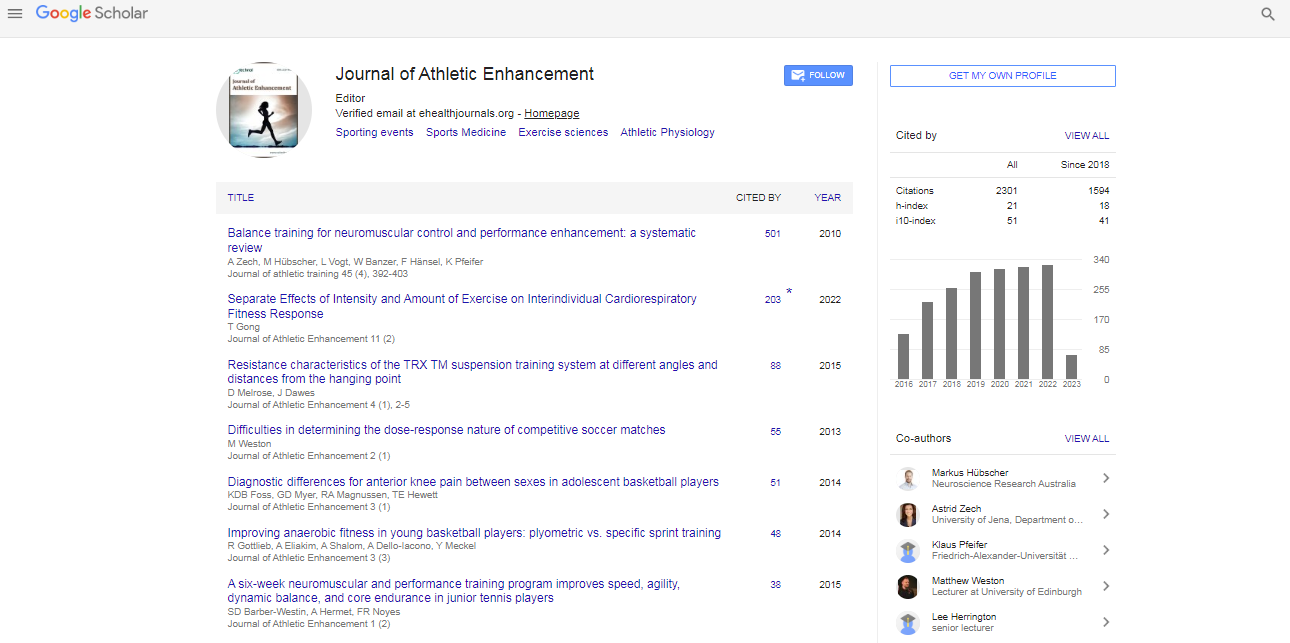Opinion Article, J Athl Enhanc Vol: 13 Issue: 5
Leg Injuries in Sports: Understanding, Prevention, and Recovery
Stephan Martin*
1Department of Sports, University of Bern, Bern, Switzerland
*Corresponding Author: Stephan Martin,
Department of Sports, University of Bern, Bern, Switzerland
E-mail: martinstephan@edu.ch
Received date: 26 August, 2024, Manuscript No. JAE-24-151417;
Editor assigned date: 28 August, 2024, PreQC No. JAE-24-151417 (PQ);
Reviewed date: 11 September, 2024, QC No. JAE-24-151417;
Revised date: 18 September, 2024, Manuscript No. JAE-24-151417 (R);
Published date: 25 September, 2024 DOI: 10.4172/2324-9080.1000148.
Citation: Martin S, (2024) Leg Injuries in Sports: Understanding, Prevention and Recovery. J Athl Enhanc 13:5.
Description
Leg injuries are among the most common ailments faced by athletes across various sports. These injuries can range from minor strains to severe fractures, significantly impacting performance and overall athletic participation.
Types of leg injuries
Leg injuries can affect various structures, including muscles, tendons, ligaments and bones. The most common types of leg injuries in sports include.
Ligament injuries: Ligament injuries, such as sprains, occur when ligaments (the connective tissues that connect bones) are stretched or torn. The most notable ligament injury in the leg is an Anterior Cruciate Ligament (ACL) tear, commonly associated with sports that involve sudden stops or changes in direction, like basketball and soccer.
Tendon injuries: Tendon injuries, including tendonitis and tears, are common in athletes. Achilles tendonitis, which affects the tendon connecting the calf muscles to the heel bone, is a prevalent issue in runners and other athletes who engage in repetitive activities.
Fractures: Fractures are breaks in the bone and can be either stress fractures (small cracks caused by overuse) or acute fractures resulting from a traumatic event, such as a fall or collision. The tibia and fibula, the two long bones in the lower leg, are frequently involved in sportsrelated fractures.
Shin splints: Medial tibial stress syndrome, commonly known as shin splints, causes pain along the shinbone (tibia) and is often associated with overuse. This injury is prevalent among runners, dancers and athletes who engage in high-impact activities.
Prevention strategies
Incorporating strength training exercises for the legs can enhance muscle stability and support surrounding joints. Focus on major muscle groups, including the quadriceps, hamstrings, calves and hip muscles. Regular flexibility training can improve the range of motion and reduce muscle tightness. Static stretching after workouts and dynamic stretching before activity can be beneficial.
Athletes should gradually increase the intensity, duration and frequency of their training to avoid overuse injuries. Following the “10% rule,” which suggests increasing training volume by no more than 10% per week, can help prevent injuries. Selecting the right footwear for specific sports and regularly replacing worn-out shoes can provide the necessary support and cushioning to protect the legs. Being mindful of playing surfaces can help athletes adapt their training and competition strategies to reduce the risk of injury. Whenever possible, choose surfaces that are appropriate for the sport. Incorporating a thorough warm-up routine that includes dynamic movements can prepare the legs for activity. A proper cool-down with stretching can aid in recovery and reduce muscle soreness.
Leg injuries are a significant concern in sports, affecting athletes of all levels. Understanding the types of leg injuries, their causes and effective prevention and recovery strategies is important for maintaining athletic performance and ensuring long-term health. By prioritizing strength training, proper conditioning and awareness of risk factors, athletes can reduce the incidence of leg injuries and enhance their overall performance. With a focus on injury prevention and appropriate management, athletes can continue to enjoy their sports and achieve their goals with confidence.
 Spanish
Spanish  Chinese
Chinese  Russian
Russian  German
German  French
French  Japanese
Japanese  Portuguese
Portuguese  Hindi
Hindi 
